Tarantulas are among the most fascinating arachnids found in Texas, known for their large size, hairy bodies, and nocturnal habits. From the reddish legs of the Texas Rose Tarantula to the golden legs of the Texas Gold Tarantula, each species has unique features that make them a remarkable part of the state’s wildlife. Whether you spot one in a grassy prairie or a desert scrubland, these spiders play an important role in controlling insect populations.
In this guide, we’ll explore 12 types of tarantulas that call Texas home, highlighting their key characteristics, habitats, and behaviors. You’ll also learn how to identify each species and discover some fun facts about these impressive arachnids along the way.
Common Tarantulas Found in Texas
Texas Brown Tarantula (Aphonopelma hentzi)

The Texas Brown Tarantula is one of the most familiar tarantula species in Texas, recognized for its solid brown body accented with reddish hairs along the legs. Its large, hairy appearance can reach a leg span of up to 5 inches, making it impressive yet non-aggressive toward humans. The reddish hairs help in distinguishing it from other brown tarantulas in the region.
This species is commonly found across central and eastern Texas, thriving in grasslands and prairies where they dig shallow burrows or occupy abandoned rodent holes. They are primarily nocturnal hunters, feeding on insects, small lizards, and occasionally small mammals. Their slow, deliberate movements are characteristic, but they can move quickly if threatened.
Behaviorally, Texas Brown Tarantulas are solitary and spend most of their lives in or near their burrows. During mating season, males leave their burrows in search of females, sometimes crossing roads and open fields. Females can live up to 25 years in captivity, while males typically live only 5 to 10 years.
A fun fact about this species is that the Texas Brown Tarantula is often seen “dancing” during molting or mating rituals, where it raises its front legs in a display. Despite their fearsome appearance, bites are rare and usually result only in localized pain similar to a bee sting.
Texas Pink Tarantula (Aphonopelma anax)
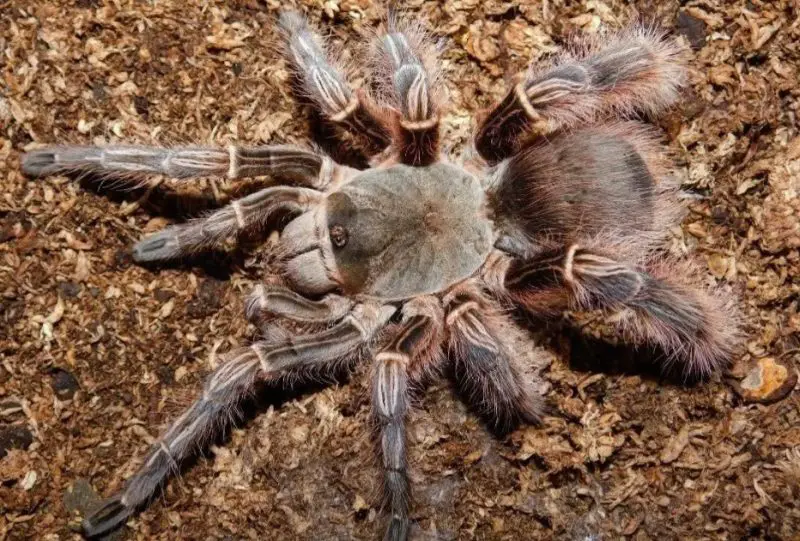
The Texas Pink Tarantula exhibits a distinctive pinkish hue on its legs contrasted with a darker, nearly chocolate-colored body. Adult specimens have a leg span ranging from 4 to 5 inches, giving them a medium-sized appearance among regional tarantulas. The subtle pink coloring makes this species visually unique, especially under natural sunlight.
This tarantula prefers the semi-arid and rocky habitats of western Texas, including scrublands and desert margins. It typically constructs burrows under rocks or within dry soil to escape the harsh daytime heat. Being nocturnal, it emerges at night to hunt insects and other small arthropods.
In terms of behavior, Texas Pink Tarantulas are shy and avoid human contact whenever possible. They rely on their burrows for protection and rarely display aggressive behavior unless provoked. Males roam widely during mating season, often traveling significant distances in search of females.
A fun fact is that despite their delicate appearance, these tarantulas are hardy and can survive drought conditions by retreating deep into their burrows for long periods. Their slow movement and subtle coloration often make them difficult for predators to detect.
Texas Tan Tarantula (Aphonopelma moderatum)
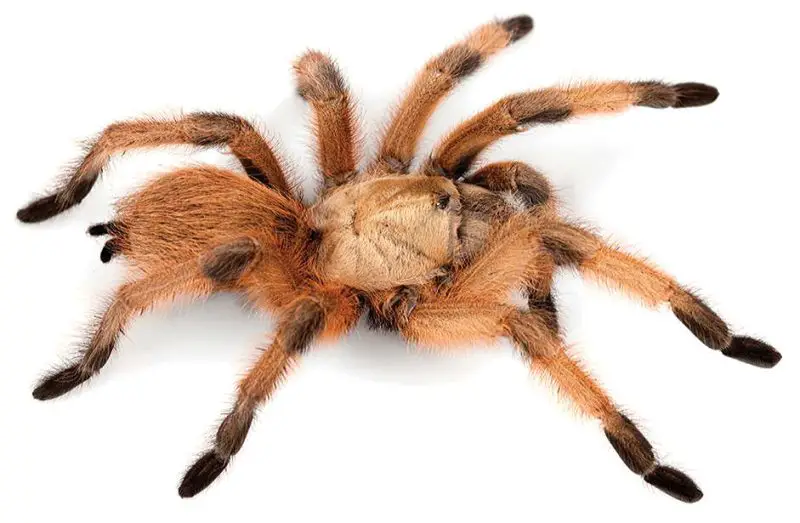
The Texas Tan Tarantula is easily recognized by its pale tan body and legs, blending seamlessly with sandy soils and desert landscapes. Adults typically reach a leg span of 4 to 5 inches. Their muted coloration provides excellent camouflage in their preferred dry and arid habitats.
This species inhabits the western and southwestern parts of Texas, favoring desert plains, scrublands, and rocky areas. It constructs deep burrows to maintain moisture and avoid extreme temperatures, spending much of its time underground during the hot daylight hours.
Behaviorally, Texas Tan Tarantulas are primarily nocturnal and ambush predators, feeding on insects, beetles, and small vertebrates that venture near their burrows. Males are more mobile than females, especially during mating season, while females often remain near the entrance to their burrows.
A fun fact about this tarantula is that it can survive long periods without food by slowing its metabolism in its burrow, a remarkable adaptation to its harsh environment. While their appearance may seem intimidating, they are gentle creatures unless provoked.
Arizona Blonde Tarantula (Aphonopelma chalcodes)
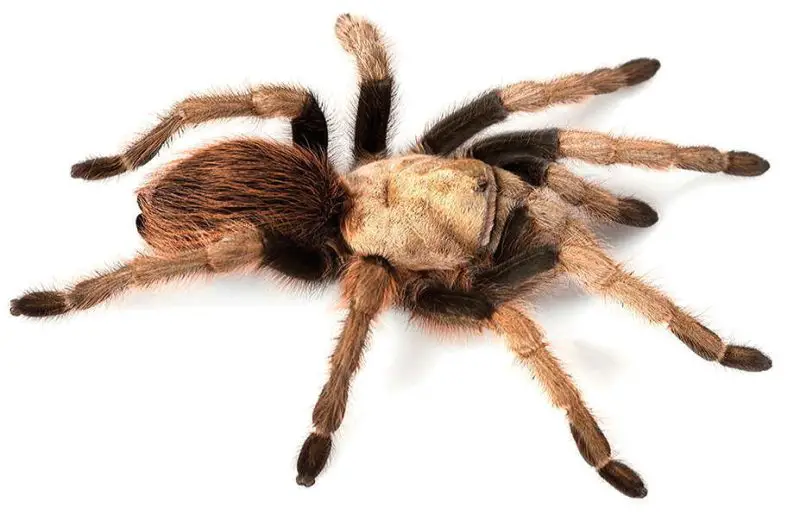
The Arizona Blonde Tarantula is known for its striking golden or blonde legs paired with a darker brown or black carapace. Adults typically have a leg span of 4.5 to 5 inches, making them one of the larger tarantulas in western Texas. Their distinctive coloration makes them highly recognizable.
This species is native to the desert regions of Arizona but can occasionally be found in western Texas, particularly near the Arizona border. They prefer arid, sandy habitats and often create burrows under rocks or in soft soil. These burrows provide protection from predators and the harsh sun.
Behaviorally, Arizona Blonde Tarantulas are nocturnal hunters, preying on insects, scorpions, and other small invertebrates. Males are active wanderers during mating season, while females generally remain in their burrows, sometimes for decades.
A fun fact is that Arizona Blonde Tarantulas are popular in the pet trade due to their striking appearance and relatively docile nature. In the wild, they can flick urticating hairs as a defense mechanism, which can cause irritation to human skin but rarely serious harm.
Texas Rose Tarantula (Aphonopelma iodius)
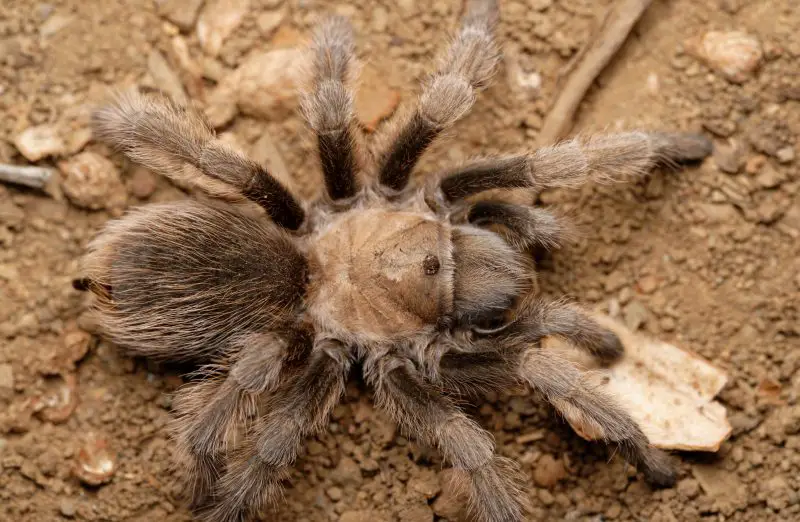
The Texas Rose Tarantula stands out with its vibrant reddish or rose-colored legs contrasting with a darker brown body. Adults usually have a leg span of 4 to 5 inches, and their coloration provides some camouflage among scrubland vegetation. The rose tint is especially noticeable under sunlight.
This species is primarily found in southern Texas, inhabiting scrublands, brushy fields, and open woodland edges. It favors dry soils for burrow construction, often lining the entrance with silk to help trap prey and deter predators.
Behaviorally, Texas Rose Tarantulas are nocturnal hunters and exhibit typical tarantula behaviors such as burrow ambush and slow, deliberate movement. Males leave their burrows to seek mates, sometimes traveling hundreds of meters over nights. Females tend to stay close to their burrow for life.
A fun fact is that this tarantula’s rose-colored legs can appear almost iridescent under certain lighting, making it a favorite among photographers and arachnid enthusiasts. Despite their intimidating appearance, bites are rare and generally harmless.
Texas Gold Tarantula (Aphonopelma gurleyi)

The Texas Gold Tarantula is notable for its shimmering gold-tinted legs, which contrast with a darker brown or black carapace. Adults can reach a leg span of 5 inches, giving them a commanding presence among the grassland tarantulas. Their golden legs are particularly reflective under sunlight.
This species inhabits open plains, rocky outcrops, and semi-arid regions of Texas, where it digs burrows in loose soil or among rocks. The burrows help regulate temperature and moisture, providing a safe retreat from predators and extreme weather.
Behaviorally, Texas Gold Tarantulas are nocturnal ambush predators that feed mainly on insects and other small arthropods. Males are active travelers during mating season, while females remain close to their burrows, sometimes for decades. They are generally docile but can flick urticating hairs when threatened.
A fun fact is that the reflective gold coloration of this tarantula’s legs can act as a natural warning to predators, making them appear larger or more intimidating than they actually are. Their longevity and resilience make them a fascinating species for arachnologists and hobbyists alike.
Texas Smoky Tarantula (Aphonopelma seemanni)
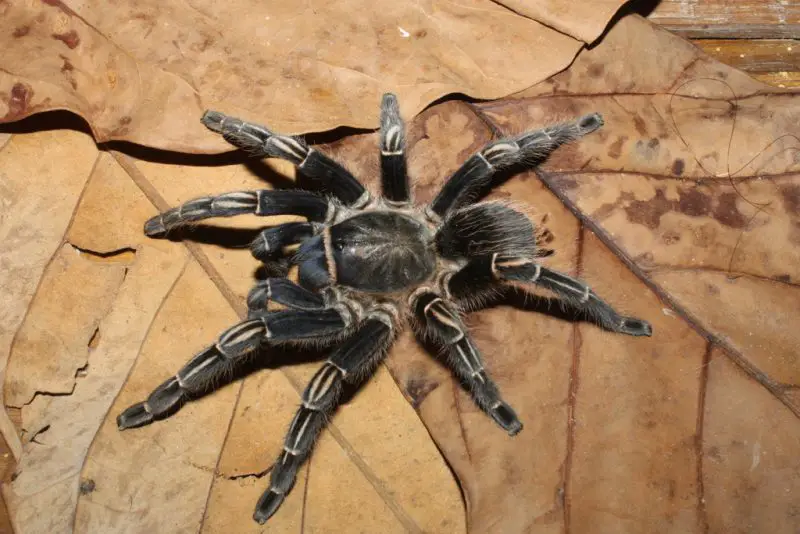
The Texas Smoky Tarantula is distinguished by its smoky gray to nearly black coloration, giving it a striking, shadowy appearance. Adult specimens can have a leg span of 4 to 5 inches, with a hairy body that helps in sensing vibrations in their surroundings. The dark coloration provides excellent camouflage against the rocky and sandy soils of southwestern Texas.
This species inhabits southwestern Texas deserts and scrublands, often building burrows under rocks or in loose soil. They prefer dry environments and tend to stay hidden during the hot daylight hours, emerging at night to hunt insects and small invertebrates.
Behaviorally, Texas Smoky Tarantulas are solitary and slow-moving, relying on their burrows for safety. Males wander extensively during mating season, whereas females typically remain in the same burrow for much of their lives. They are generally docile but will flick urticating hairs if threatened.
A fun fact about this tarantula is that its dark smoky coloration can make it nearly invisible at night, providing a natural advantage both for ambushing prey and avoiding predators. Despite their intimidating appearance, bites are rare and usually mild.
Mesquite Tarantula (Aphonopelma vorhiesi)
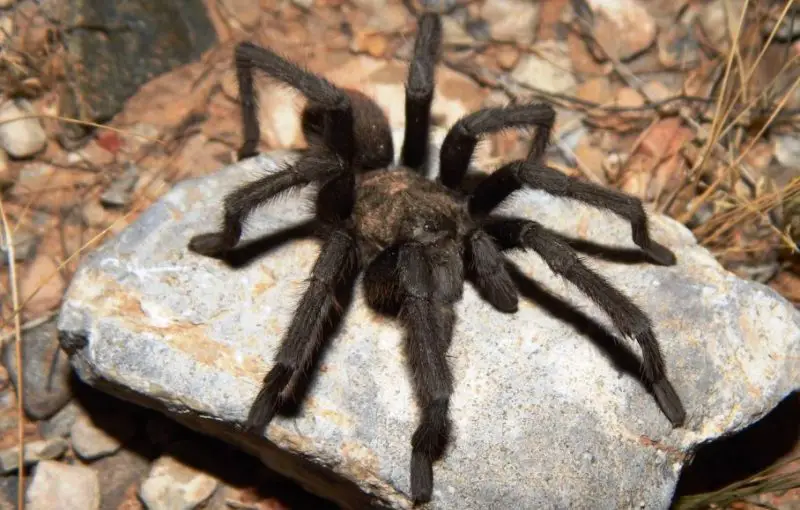
The Mesquite Tarantula is easily recognized by its brownish-gray body and thick, sturdy legs, which give it a robust appearance. Adults have a leg span ranging from 4.5 to 5 inches. Its coloration blends perfectly with the leaf litter and soil of mesquite woodlands, making it difficult to spot in its natural habitat.
This species is native to southern Texas, thriving in mesquite-dominated woodlands and scrublands. It constructs burrows under fallen logs, rocks, or in loose soil, which provide shelter from predators and the hot daytime sun. Mesquite Tarantulas are nocturnal, hunting insects, beetles, and other small arthropods at night.
Behaviorally, they are solitary and rely heavily on their burrows for protection. During mating season, males leave their burrows to search for females, sometimes traveling long distances. Females are long-lived and remain close to their burrows for years, occasionally decorating the entrances with silk.
A fun fact is that Mesquite Tarantulas are particularly strong diggers, capable of creating burrows up to several feet deep. Their sturdy legs help them maneuver through dense woodland and rough terrain with ease.
Desert Blond Tarantula (Aphonopelma paloma)
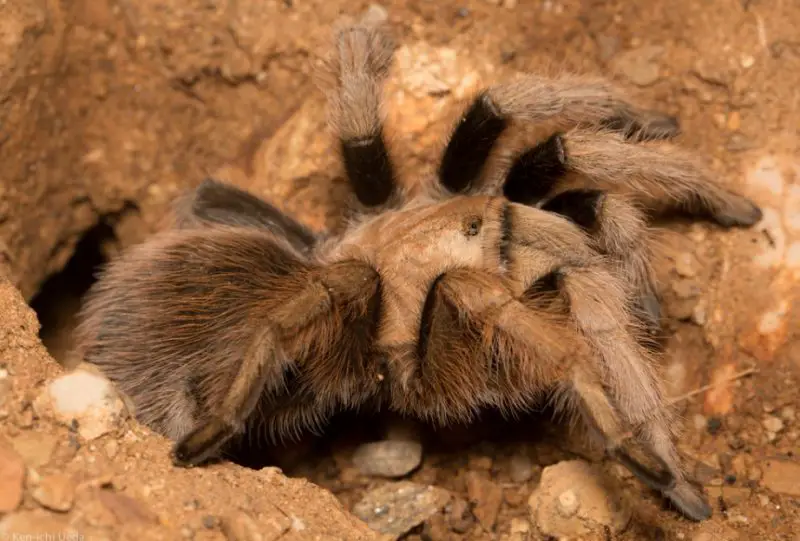
The Desert Blond Tarantula features a pale, sandy-colored body that blends seamlessly with desert sands and rocky terrain. Adults typically have a leg span of 4 to 5 inches, and their subtle coloration provides excellent camouflage against predators and prey alike.
This species inhabits arid western Texas and desert regions, including scrublands and rocky plains. They create burrows in sandy soil or under rocks, which help maintain humidity and shelter from the extreme desert heat. They emerge primarily at night to hunt insects and small invertebrates.
Behaviorally, Desert Blond Tarantulas are mostly sedentary, spending much of their lives near their burrows. Males become more mobile during mating season, wandering to locate females. Females tend to live for decades, maintaining the same burrow throughout their lives.
A fun fact is that the pale coloration of Desert Blond Tarantulas is a natural adaptation to desert life, reflecting sunlight and reducing the risk of overheating. Despite their harsh environment, these tarantulas can survive long periods without food or water.
Rio Grande Tarantula (Aphonopelma pallidum)
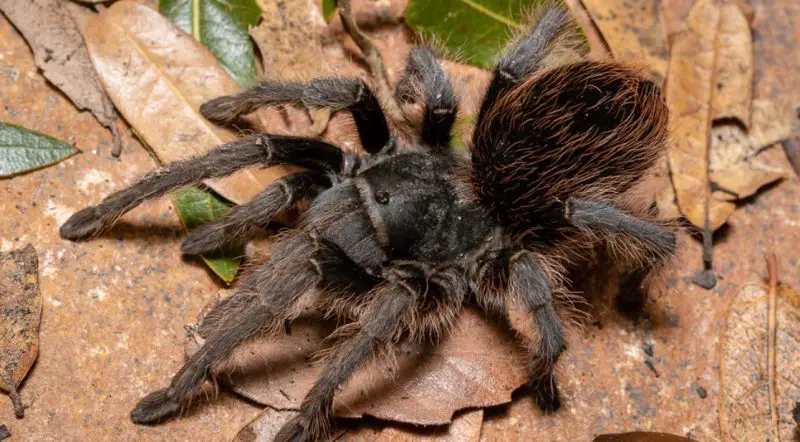
The Rio Grande Tarantula is characterized by its pale legs and darker brown body, offering a subtle yet distinct contrast. Adults usually have a leg span of 4.5 to 5 inches. Its coloration helps it blend with the mixed soils and vegetation along the Rio Grande Valley.
This species is native to the Rio Grande Valley region of southern Texas, where it inhabits grasslands, scrub, and riverbank areas. It constructs burrows in loose soil, often near vegetation or rocks, which serve as protection from both predators and extreme temperatures.
Behaviorally, Rio Grande Tarantulas are nocturnal hunters, feeding on insects, spiders, and occasionally small vertebrates. Males leave their burrows to seek mates, while females typically remain near their burrows for life. They exhibit defensive behavior by raising their front legs or flicking urticating hairs when threatened.
A fun fact about this species is that it is sometimes seen crossing roads or paths at night during mating season, making them a favorite for wildlife photographers exploring the Rio Grande Valley. Their striking leg coloration is subtle but distinctive for identification.
Big Bend Tarantula (Aphonopelma marxi)
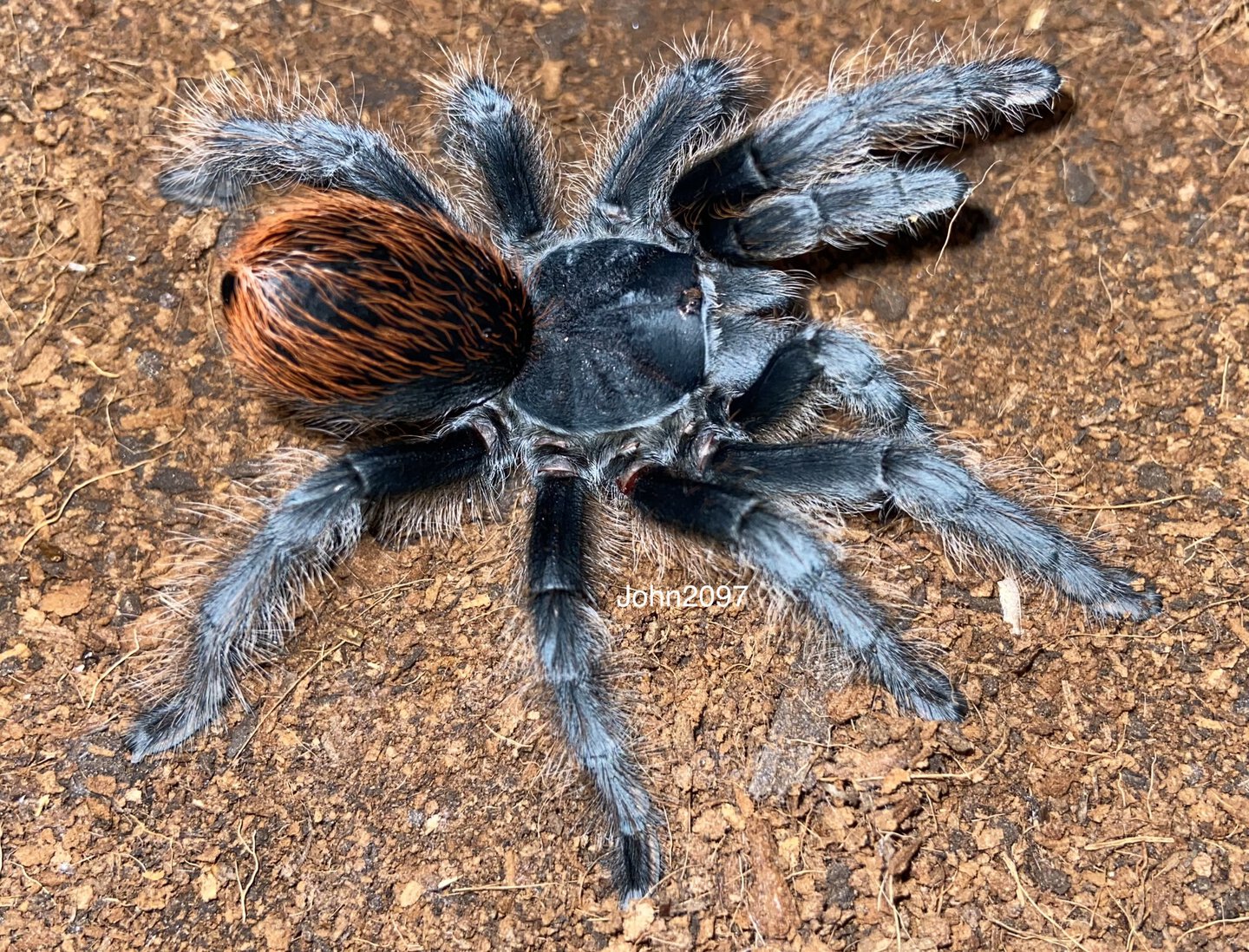
The Big Bend Tarantula has a dark brown to black body with thick, hairy legs, making it one of the more visually striking tarantulas in West Texas. Adults can reach a leg span of 5 inches or more. Its dark coloration provides camouflage against the rocky and arid landscapes of the Big Bend region.
This species is found in the rugged desert and mountain regions of West Texas, especially within the Big Bend area. They dig burrows in rocky soil or under stones, providing shelter from predators and extreme heat. Being nocturnal, they are active at night while avoiding the harsh daytime temperatures.
Behaviorally, Big Bend Tarantulas are slow-moving ambush predators, feeding primarily on insects and other small arthropods. Males wander during mating season, while females remain in their burrows for long periods, often several decades.
A fun fact is that the Big Bend Tarantula is well-adapted to its harsh environment, able to survive long periods without food or water. Their dark coloration also helps absorb heat during cooler nights, aiding in thermoregulation.
Eastern Texas Tarantula (Aphonopelma anitah)

The Eastern Texas Tarantula exhibits a medium brown body with subtle orange hues on the legs and carapace. Adults typically have a leg span of 4 to 5 inches, and their coloring blends well with forest floors, leaf litter, and grassland soils. The faint orange hints provide a gentle contrast that aids in identification.
This species inhabits the forests, grasslands, and woodland edges of eastern Texas. It digs burrows in loose soil or occupies abandoned rodent holes, which offer shelter and moisture retention. They are primarily nocturnal, venturing out to hunt insects, spiders, and occasionally small reptiles.
Behaviorally, Eastern Texas Tarantulas are solitary and rely on burrows for safety. Males travel extensively during mating season to locate females, whereas females generally remain near their burrows for most of their lives. They are not aggressive but will defend themselves with urticating hairs when provoked.
A fun fact about this tarantula is that its subtle orange hue becomes more vivid under direct sunlight, giving it a “glowing” appearance that can surprise observers. Despite their intimidating look, they pose little threat to humans.
FAQs About Tarantulas in Texas
What types of tarantulas are found in Texas?
Texas is home to numerous tarantula species, including the Texas Brown Tarantula, Texas Pink Tarantula, Texas Tan Tarantula, Arizona Blonde Tarantula, Texas Rose Tarantula, Texas Gold Tarantula, Texas Smoky Tarantula, Mesquite Tarantula, Desert Blond Tarantula, Rio Grande Tarantula, Big Bend Tarantula, and Eastern Texas Tarantula. Each species has unique coloration, habitat preferences, and behaviors.
Are Texas tarantulas dangerous to humans?
Most Texas tarantulas are not dangerous to humans. They may bite if provoked, but their venom is generally mild, causing only localized pain similar to a bee sting. They can also flick urticating hairs from their abdomen, which may cause skin or eye irritation.
When are Texas tarantulas most active?
Texas tarantulas are primarily nocturnal. They spend the daytime in burrows or under rocks to escape the heat and emerge at night to hunt insects and other small prey. Male tarantulas are particularly active during mating season.
Where do Texas tarantulas live?
Tarantulas in Texas inhabit a variety of ecosystems. Some species, like the Texas Brown Tarantula, are common in grasslands and prairies, while others, such as the Desert Blond or Arizona Blonde Tarantulas, prefer arid deserts and rocky regions. Mesquite Tarantulas thrive in mesquite woodlands, and Rio Grande Tarantulas are found near river valleys.
How big do Texas tarantulas get?
Most adult Texas tarantulas have a leg span of 4 to 5 inches. Some species, like the Big Bend Tarantula and Texas Gold Tarantula, can reach slightly larger sizes. Despite their impressive size, they are relatively slow-moving and non-aggressive.
What do Texas tarantulas eat?
Texas tarantulas are carnivorous and feed mainly on insects such as crickets, beetles, and grasshoppers. They may also eat small spiders, scorpions, or even tiny vertebrates. They ambush prey near the entrance of their burrows or actively hunt at night.
How long do Texas tarantulas live?
Female Texas tarantulas can live up to 20–30 years in the wild, while males generally live 5–10 years. Longevity varies by species, but females often remain near the same burrow for most of their lives.
Can Texas tarantulas be kept as pets?
Yes, several species like the Arizona Blonde and Texas Brown Tarantula are popular in the pet trade due to their docile nature and striking appearance. They require specific temperature, humidity, and enclosure conditions to thrive in captivity.






